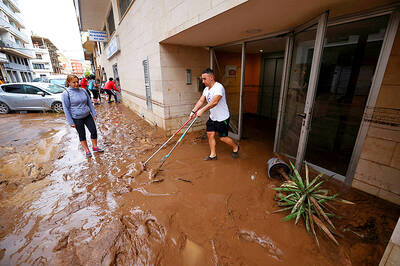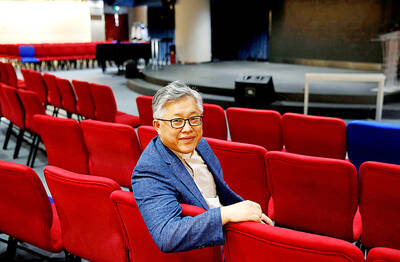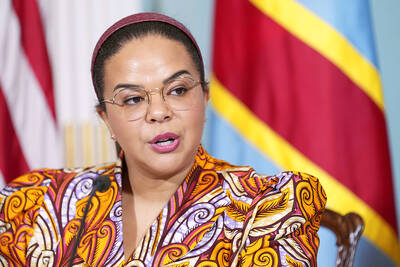A controversial art installation that pitted live caged animals against each other was to close yesterday, after the Chinese-French artist was accused of cruelty.
Internationally-known artist Huang Yong Ping, a Chinese who now lives in Paris, announced the animals in a enclosure will be removed "to maintain the integrity of the artwork."
The British Columbia Society for the Prevention of Cruelty to Animals (SPCA) had ordered Huang and the Vancouver Art Gallery to drastically modify the exhibit.
By provincial law, the agency can investigate and lay charges of animal cruelty.
Since opening a week ago, the "Theater of the World" housed lizards, scorpions, tarantulas and other animals together in a cage.
Kathleen Bartels, director of the Vancouver Art Gallery, said the installation "encouraged people to think seriously about the dynamics of power in today's society."
But a fierce dispute over animal rights and artistic freedom immediately broke out in this western Canadian metropolis.
"We were called in on an animal cruelty complaint," SPCA spokesperson Lorie Chortyk said. "People were concerned about different species coexisting in that habitat ... They are species from different parts of the world that would not normally be with each other."
The cage is an oval-shaped plywood table with a wire-mesh cover in the shape of a turtle.
When this reporter visited, chirping crickets swarmed over the cage floor, a lizard sat motionless near the center while scorpions and large black hairy tarantulas pressed near the outer edges.
A guard hovered nearby, telling people not to touch the cage as groups of schoolchildren pressed close and shrieked at the sight of the creatures.
Carol Gigliotti, a professor at the Emily Carr Institute of Art and Design in Vancouver with a specialty in animal ethics, said the display conveyed the element of chance, the reality the animals could kill each other, and the fact that "death is imminent and people have to accept this."
Gigliotti said she realized that Huang was trying to convey an abstract idea, "but the ethical choice would be to take out the animals."
The exhibit posted a disclaimer that all animals were bred in captivity and would be sent to good homes after the show closed.
"In my mind that doesn't make it right," Gigliotti said. "That's like saying, this woman was born into slavery so it's ok, she's used to it.'"
Gigliotti slammed the gallery for first displaying the animals "without water, without any place to hide, with one light source so it was very cold, they need a lot more heat."
After the SPCA's first visit the gallery provided water and hiding places, Chortyk said. Later, a veterinarian examined the animals and the SPCA ordered removal of the tarantulas and scorpions.
Instead, said Huang in the release, "we must remove all the animals in `Theater of the World' but leave behind the emptied physical structure, and to do so as a sign of protest."
The gallery said the controversy would be used "to encourage discussions about freedom of expression, power and censorship."
The live-animal display is part of House of Oracles: A Huang Yong Ping Retrospective, which was earlier shown in Minneapolis, Minnesota and the North Adams, Massachusetts with no changes.

STEPPING UP: Diminished US polar science presence mean opportunities for the UK and other countries, although China or Russia might also fill that gap, a researcher said The UK’s flagship polar research vessel is to head to Antarctica next week to help advance dozens of climate change-linked science projects, as Western nations spearhead studies there while the US withdraws. The RRS Sir David Attenborough, a state-of-the-art ship named after the renowned British naturalist, would aid research on everything from “hunting underwater tsunamis” to tracking glacier melt and whale populations. Operated by the British Antarctic Survey (BAS), the country’s polar research institute, the 15,000-tonne icebreaker — boasting a helipad, and various laboratories and gadgetry — is pivotal to the UK’s efforts to assess climate change’s impact there. “The saying goes

Floods on Sunday trapped people in vehicles and homes in Spain as torrential rain drenched the northeastern Catalonia region, a day after downpours unleashed travel chaos on the Mediterranean island of Ibiza. Local media shared videos of roaring torrents of brown water tearing through streets and submerging vehicles. National weather agency AEMET decreed the highest red alert in the province of Tarragona, warning of 180mm of rain in 12 hours in the Ebro River delta. Catalan fire service spokesman Oriol Corbella told reporters people had been caught by surprise, with people trapped “inside vehicles, in buildings, on ground floors.” Santa Barbara Mayor Josep Lluis

Police in China detained dozens of pastors of one of its largest underground churches over the weekend, a church spokesperson and relatives said, in the biggest crackdown on Christians since 2018. The detentions, which come amid renewed China-US tensions after Beijing dramatically expanded rare earth export controls last week, drew condemnation from US Secretary of State Marco Rubio, who on Sunday called for the immediate release of the pastors. Pastor Jin Mingri (金明日), founder of Zion Church, an unofficial “house church” not sanctioned by the Chinese government, was detained at his home in the southern city of Beihai on Friday evening, said

SANCTIONS: Congolese Minister of Foreign Affairs Therese Kayikwamba Wagner called on the EU to tighten sanctions against Rwanda during an event in Brussels The Democratic Republic of the Congo (DR Congo) has accused the EU of “an obvious double standard” for maintaining a minerals deal with Rwanda to supply Europe’s high-tech industries when it deployed a far-wider sanctions regime in response to the war in Ukraine. Congolese Minister of Foreign Affairs Therese Kayikwamba Wagner urged the EU to levy much stronger sanctions against Rwanda, which has fueled the conflict in the eastern DR Congo, describing the bloc’s response to breaches of the DR Congo’s territory as “very timid.” Referencing the EU’s response to Russia’s invasion of Ukraine, she said: “It is an obvious double standard